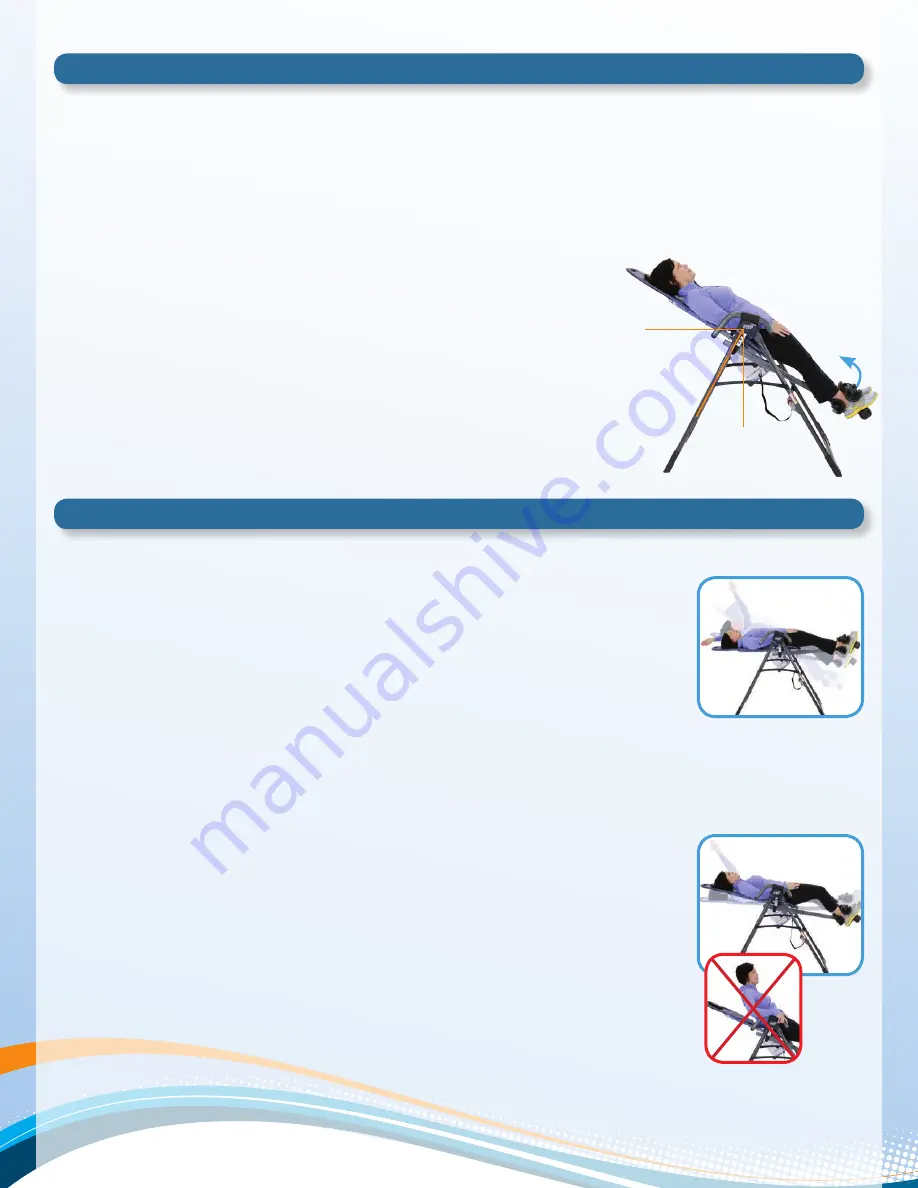
Figure 17
Balanced Correctly: Main Shaft
lifts slightly off Crossbar
0°
horizontal
60°
90°
Figure 18
Figure 19
Figure 20
Prepare to Invert
(continued)
Inverting
Rotating Into Inversion
If correctly balanced, the inversion table will rotate in response to simple arm movements.
Your arms provide the weight needed to rotate the inversion table. (Figure 18):
• To invert, lift your arms overhead slowly (shift weight to the head-end of the Table Bed).
• To return upright, slowly bring your arms back to your sides (shift weight to the foot-end).
To ensure the inversion table does not rotate too far, too quickly, be sure that you have
attached the Angle Tether and completed the balance testing.
1. With your head resting against the Table Bed, raise one arm at a time to begin rotation.
For maximum control and comfort, every movement should be slow and deliberate (the
faster you move, the faster the inversion table will rotate).
2.
Practice controlling the speed and angle of rotation by moving your arms back and forth.
3. Once you’ve reached the maximum angle allowed by the Angle Tether, rest both arms
over your head. Relax and breathe deeply to help your muscles relax.
Returning Upright
4.
To begin rotating back to starting position, slowly bring your arms to your sides.
5. Stop and rest for a few minutes just past horizontal (0°) to help prevent dizziness and
allow your back to re-compress without discomfort before returning completely upright.
Since your body may have lengthened or shifted on the Table Bed while inverted, arm
movements may not be enough to return you completely upright. Simply bend your knees
slightly while shifting your body weight toward the foot-end of the Table Bed (Figure 19).
DO NOT
lift your head, rely solely on the handles or try to sit up (Figure 20), as this will
counteract the relaxing benefits of inversion you’ve just experienced.
If you still have trouble returning upright after following these suggestions, consider adjusting
your User Settings and testing your balance and rotation control again.
Owner’s Manual Pg. 4
Testing Your Balance and Rotation Control
When adjusted properly, you will have total control over the rotation of the inversion table by simply shifting the weight/
position of your arms. Your ideal balance settings are determined by your body type and weight distribution - this is why
your Main Shaft setting may differ from your actual height.
Struggling to invert or return upright will counteract the benefits of inversion. It’s important to take time, test your settings,
and ensure a relaxing, enjoyable experience!
For your first few inversion sessions, ask a spotter to assist you until
you are able to find your correct balance setting and are comfortable with the operation of the inversion table.
1. Lean back and rest your head on the Table Bed with your arms at your sides.
• If balanced correctly, the inversion table should begin to rotate slightly, with
the Main Shaft lifting a few inches off the bumper of the Crossbar (Figure 17).
• If the inversion table rotates so that the Main Shaft lifts more than a few inches
off the Crossbar, to horizontal (0
o
) or beyond, your Main Shaft may be too short.
Carefully dismount,
lengthen
the height setting by one hole, secure your ankles
again and re-test.
• If the inversion table does not rotate at all, and the Main Shaft remains seated
firmly on the Crossbar, your Main Shaft may be too long. Carefully dismount,
shorten
the height setting by one hole, secure your ankles again and re-test.
Your Main Shaft setting should remain the same as long as you continue to use the same
Roller Hinge setting and your weight does not fluctuate substantially. If you decide to
change your Roller Hinge setting, you should test your balance and control again.
























